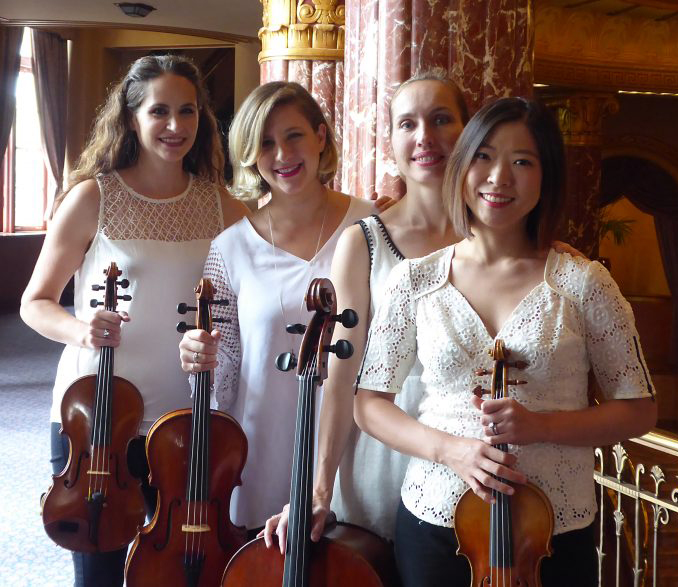by Kevin McLaughlin

Founded in 2009, Omni Quartet members Amy Lee and Alicia Koelz (violins), Joanna Zakany (viola), and Tanya Ell (cello), all members of The Cleveland Orchestra, were convivial hosts, guiding the audience with verbal introductions to each work and brief excerpts by way of guideposts. While this can be overdone, here it was just enough to help the listener stay on the path. The commentaries and demonstrations worked out ahead of time were the most effective.
In her remarks about Haydn’s Quartet in F, Op. 77, No. 2, violinist Alicia Koelz emphasized the humor and elements of surprise present in the work. Sure enough, Haydn made us laugh, even when we knew the comedy was coming. Whether in the harmonic meanderings, the startling unison tremolo in the first movement, the rhythmic hijinks in the Minuet (a 2/4 march embedded in 3/4), or similar tugs of two against three in the final Vivace, the Omni told every joke with perfect timing and drollery. Koelz, playing first violin, amazed in the Rossini-like barnburner of a finale. Speed and rhythm were kept exact in both soft and loud passages. And is it possible that after the last chord I smelled smoke?
Violist Joanna Zakany’s introduction to Caroline Shaw’s Entr’acte (2011) included this composer note: “Entr’acte is an homage to the second movement (minuet) of Haydn’s Op. 77, No. 2, but in a kind of absurd, subtle, technicolor transition…[taking] you to the other side of Alice’s looking glass.”
Aside from the structure, perhaps, the exact reference to Haydn’s work is, as Zakany admitted, hard to pin down. Things are, as the composer says, “taken a little further,” with pop fragments, irregular rhythms, sighing noises, and phantom pitches. Such flourishes aren’t mere surface ornament but intrinsic gestures, as essential as the textures and themes in Haydn’s sound world.
Toward the beginning of the piece, Shaw asks players to produce “pitchless bow noise,” moving the bow as normal but using almost no finger pressure. The resulting sound — or lack of it — was like seeing a ventriloquist’s trick.
Shaw shows an innate understanding of string playing (she is a violinist herself), evidenced by the range of expression she summons, from rhythmic pizzicato to high-wire harmonics, hoe-down revelry, Renaissance dances — and was that the Beatles at the end? The Omni responded to all of it with a mesmerizing and thoroughly satisfying performance.
On the second half, Mendelssohn’s Op. 44, No. 1 Quartet found a sympathetic partner in the Omni, ending the program on a buoyant and joyous note. Cellist Tanya Ell introduced the work engagingly with members of the ensemble providing a sampling of themes, and first violinist Amy Lee’s opening notes seemed to burst out of her like a firework, setting the tone throttle on high. But the group needed no external impetus to find and maintain its momentum.
The Omni is an uncommonly unified ensemble. They play with a full-bodied, European sound, golden and full-throated — passion abetted by rhythmic scruple. Full bows and exact rhythm, especially in the work’s frequent iteration of dotted-quarter and eighths, served to convince. Great tonal control, or what singers and wind players call “breath control,” was also on display, and timbre remained even, whether at forte or at the end of the softest diminuendo. The Andante was an indulgence, surrendering more to Romantic lyricism than to 18th-century delicacy, and the Presto bubbled. This was a jubilant performance of an under-played work, similar in affect to Mendelssohn’s more frequently played Octet, but, if possible, with even more exuberance.
Published on ClevelandClassical.com March 7, 2023.
Click Here for a printable copy of this article


